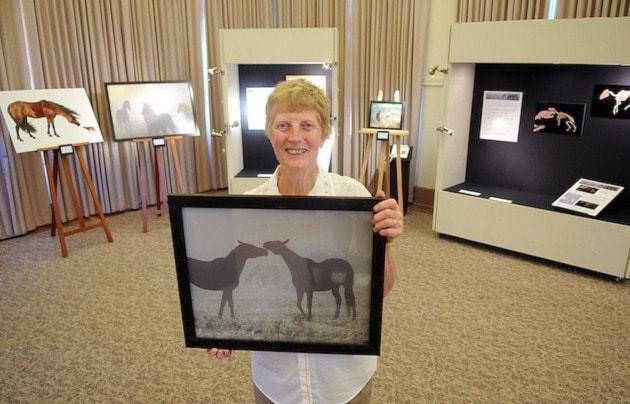The new exhibit in the gallery at the Chilliwack Museum is an ode to the exhilarating beauty of the horse.
The show Horses From the Mists of Time blends the journalism and photo skills of Ryder Lake resident Margaret Evans, with a photographic display in the Chambers Gallery series that explores the evolution of horses.
"Horses are beautiful, fascinating and highly adaptable animals," says Evans. "I know from the many talks I have given that horses captivate people."
She's owned them for years, and rode often as a child.
"Even if they have never ridden a horse, people are still intrigued by an animal that is so big and powerful, yet so gentle and capable of giving so much in work, sport, recreation, and therapy.
"I felt that telling their evolutionary story, even conceptually, would be appealing to many visitors."
She was thrilled to garner the support of governments, universities, and other museums, which agreed to provide photographic material that would bolster the show.
"Their photographs and information were central to making this exhibit a success," she said.
Evans has been a writer for more than 40 years and has owned horses for three plus decades.
"I rode in England as a child so I have almost always had a horse connection," she says.
In addition to her Progress column Locally Global, Evans also pens science articles (Western Producer, Country Life) and horse features (Canadian Horse Journal) and gives talks on horses.
Her last book Heart of a Hoofbeat is on sale at the Chilliwack Museum.
"Many people don’t know that horses evolved exclusively on the North American continent and they first appeared about 55 million years ago."
They've been through eye-popping changes and adaptations.
Visitors will see pictures depicting the earliest horse that was no bigger than a small dog. They will see photos of fossils dating back 17 million years as well as a 700,000 year old skull found in the Yukon. The interpretive panels show dramatic changes the horses went through, their value to humans, and the how horses are used today in conservation grazing programs.
Part of what makes them captivating is the contrast between their size, and their role in society.
"The average horse weighs around 1100 lbs (say 500 kg) but it is gentle, perceptive, and capable of the most amazing dancing steps in the dressage arena.
"As a herd animal, it will bond in friendship with a person. And yet, despite almost 6,000 years of domestication, horses still retain many of their ancient behaviours. They have never really lost that connection with the wild and their heritage."
So did she set out to depict 50 million years of evolution with photos and interpretive panels?
"It’s impossible to tell the full story of their evolution in one show," Evans admits.
She concentrated on the visual concept of the horse from 55 million years ago, and explained in panels how they adapted as climates and landscapes changed.
"I obtained photos of fossil horses from 17 million years ago showing the changes, especially as their four-toed feet were starting to become single hooves.
"I also focused on the value of ancient horses to early people, the story of their domestication, and their value today in conservation grazing programs."
There's lots to be learned.
"As it evolved through the millennia to become the a successful grassland species, the horse became the perfect animal to carry civilization on its back. It was central to human expansion, exploration, settlement, agriculture, and transportation.
"Today it is valued in sport, recreation, and therapy."
The exhibit, Horses From the Mists of Time, runs until September 26 in Chambers Gallery inside the Chilliwack Museum, 45820 Spadina Avenue.
